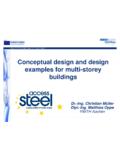Transcription of Design recommendations for multi-storey and …
1 IStructEDesign recommendations for multi -storey and underground car parks(3rd Edition)1 The Institution of Structural EngineersJune 2002 Design recommendations for multi -storey and underground car parksTHIRD EDITIONP ublished by The Institution of Structural EngineersIStructEDesign recommendations for multi -storey and underground car parks(3rd Edition)2 Constitution of Task GroupJ K KenwardBEng(Tech) CEng FIStructE MICE MIHT(Hyder Consulting Ltd) ChairmanTJ Austin*BSc CEng MICE (Canterbury City Council)R BaileyCEng MIStructE (Tarmac Precast Concrete Ltd)PR BraceyBACEng MIStructE MICE (Bracey Consulting and formerly Composite Structures)R G BrickwoodBEng(Hons) CEng MIStructE (Peter Brett Associates)S Brock**BSc CEng MICE MIHT(Mott MacDonald)J DavidBSc MSLL(CIBSE)S B DesaiOBE BE PhD FIStructE (Visiting Professor, University of Surrey) G THardingDIC CEng FIStructE MICE (Department for Transport, Local Government and the Regions)C S HarperBEng(Hons) CEng MIStructE (Corus)C K JollyMSc PhD CEng FIStructE MICE (Cranfield University (RMCS))D PikeBSc(Eng) PhD CEng FIStructE MICE MASCE FRSAMConsE (Building Design Partnership)PC RoberyBSc PhD CEng MICE MCS MICT(FaberMaunsell)C J Rooney**MIHTIEng FIHIE (Arup Transport Planning)AJ M SoaneBSc(Eng) PhD CEng FIStructE FICE MASCE MConsE (Mott MacDonald)C WWhapplesBSc(Hons) CEng FIStructE MICE MIHTFConsE (Hill Cannon Partnership)J G M WoodBSc PhD CEng FIStructE MICE FIAgrE (Structural Studies & Design Ltd)Corresponding membersR ChuCEng FIStructE MICE FHKIE (Meinhardt (C&S) Ltd, Hong Kong)
2 R Halsall BSc(Hons) CEng FIStructE FICE PEng (Halsall Associates Ltd, Canada)R LaversCEng MIStructE FRICS (Westminster City Council)M WebsterBEng MSc DIC CEng PhD MIStructE MICE (BCA) until February 2001 Secretary to the Task GroupB ChanBSc(Hons) AMIMechE (Institution of Structural Engineers)* representing the Institution of Civil Engineers** representing the Institution of Highways and TransportationGraphics: Sheila J. RudmanPublished by The Institution of Structural Engineers11 Upper Belgrave StreetLondon SW1X 8 BHUnited KingdomTelephone: +44(0) 20 7235 4535 Fax: +44(0) 20 7235 4294 Email: 0 901297 23 2 2002 The Institution of Structural EngineersThe Institution of Structural Engineers and the members who served on the Task Group which produced this reporthave endeavoured to ensure the accuracy of its contents.
3 However, the guidance and recommendations given inthe report should always be reviewed by those using the report in the light of the facts of their particular case andspecialist advice obtained as necessary. No liability for negligence or otherwise in relation to this report and itscontents is accepted by the Institution, the members of its Task Group, its servants or part of this publication may be reproduced, stored in a retrieval system or transmitted in any form or by anymeans without prior permission of the Institution of Structural Engineers who may be contacted at 11 UpperBelgrave Street, London SW1X 8BH, recommendations for multi -storey and underground car parks(3rd Edition) Scope of the Status of the Developing the brief and performance Design The Design Limitations imposed by statutory requirements and public Mixed use Information to be considered for inclusion in the The Site Highway Statutory Building Maintenance Change of Design and cost plan Design Town Building regulations and other Operational Traffic feasibility and Site feasibility Accommodation and operational Schedule/checklist of operational Cost Choice of Internal planning and management of traffic and Operational Design Dynamic capacity Aisle Vehicle Ramp Vehicle reservoir at entrance.
4 And entrance Vehicle reservoir at Bay Design Traffic Entry and exit Capacity of entry Control within the car Speed recommendations for multi -storey and underground car parks(3rd Edition) Vehicle safety Payment Control of Exit Pedestrian Pedestrian/vehicle Stairs and lift Lifting-arm and rising-step Disabled Design geometry and The Geometric Bay width and Aisle width and bin Side clearance on Column Floor Ramp and accessway Ramp and accessway curvature, widths and clearance on Entry and exit Car park Cul-de-sac One and two-way Parking Parking-area Choice of Carpark Design and Design Uniformly distributed imposed Wind Other lateral Ground Load combinations for normal Design Load combinations for abnormal Design Robustness of structural Landscape of structure to Structural Concrete Steel Composite Methods of construction and structural Design for car parks above Ground Lateral recommendations for multi -storey and underground car parks(3rd Edition)
5 Methods of construction and structural Design of underground car Categories of underground car Methods of Control of ground Designing for Movement Edge Designing edge Expected Fixing protective Requirements of long access Barriers near Protective Pedestrian Building Vehicular Pedestrian Staff Emergency Lighting Equipment multi -purpose Ramp Open top Special provisions for cold Staff Carbon monoxide Natural Mechanical Noise Electrical Electrical charging Lifts and Provision for information Provision for current Provision for future Induction Lightning Fire General Specific Fire safety Fire detection and extinguishing Automatic fire recommendations for multi -storey and underground car parks(3rd Edition)
6 Hand-held portable fire-fighting Means of Statutory Rules for Durability of the Concrete Durability risk Exposure Concrete Protection of embedded Non-ferrous Structural Basements and buried Concrete Parking Vehicle ramps and circulation Pedestrian Floor Walls, columns and Basements and buried Membranes and coatings for Concrete decks without a General deck Concrete deck waterproofing by use of a Decorative and protective Bearing Drainage and Required Parking Ramps and circulation Pedestrian Piped Proprietary movement Construction joints and non-structural Quality control during Construction Placing and Protection and Inspection and maintenance manual and structure information limitations on modifications and change of ADesigning fortemperature B Acknowledgements of recommendations for multi -storey and underground car parks(3rd Edition)
7 7 AccesswayCarriageway not adjoining bays and used solely for the movement of accessway serving adjoining parking area, exclusive of aisle or other adjoining area, allocated to one rows of bays with the access aisle running between them. Ahalf-bin is one row of bays and theaisle serving rampAramp system that does not include an aisle in its circulation and which provides unencumberedaccess between the parking floors and an entrance or at any level of the car capacityThis term may be applied either to the individual parts of a car park or to a car park as a is the maximum flow per hour of cars, or where appropriate, people, which the part of the car parkor the car park as a whole, as the case may be, can angleThe angle between the longitudinal centreline of a bay and the aisle from which it is accessway or aisle connecting parking areas at different levels.
8 More usually, the term is appliedto accessways accessway where cars may queue without obstructing movements in other parts of a car park orthe external road system. Areservoir may also be described as a vehicle capacityThe total number of bays in a car recommendations for multi -storey and underground car parks(3rd Edition)8 IStructEDesign recommendations for multi -storey and underground car parks(3rd Edition)9 The first edition of the car park Design guidance document was prepared in the late 1970s and updated in 1984. Inthe intervening years, the perception and Design features of multi -storey car parks have changed significantly. Thegrowth of car usage and increased familiarity with different multi -storey car park facilities has led to increased publicexpectations on issues such as security and ease of access.
9 There has also been interest in upgrading provisions forcar parking as a marketable facility. Increasingly, car parks are recognised as an integral and vital part of adevelopment, often forming the first impression a visitor has of a town or specific development. Many car parks designed in the 1960s and 1970s continue to give satisfactory levels of service and structuralperformance. However, some failures were reported in the mid-1990s, which mainly involved the older stock of carpark structures. Among these incidents was failure of car park barriers caused by accidental impact that resulted incars falling onto the lower floors. There were other well publicised failures, one caused by concrete degradation withreinforcement corrosion in a slab, the structural consequences of which were not appreciated before a punchingshear failure initiated a partial progressive collapse.
10 In recognition of the development of car park technology andto allow the lessons learnt from such failures to be incorporated into Design guidance, the current review ofInstitution guidance was begun in July review noted that failures in older car parks frequently related to inadequate Design details and insufficientunderstanding of the exposure conditions to which the structures could be subjected. Moreover, the performance ofdrainage and waterproofing, which are vital for durability of the floors, was found to be inadequate, whether as aresult of bad detailing or insufficient quality control during construction. The situation was worsened by the absenceof proper monitoring and maintenance. Regular and timely monitoring, inspection and maintenance of car parks bystaff experienced in the particular mechanisms of corrosion and structural deterioration were also seen as nature and mechanisms of certain forms of collapse give little prior warning of structural distress to theinexperienced eye.




